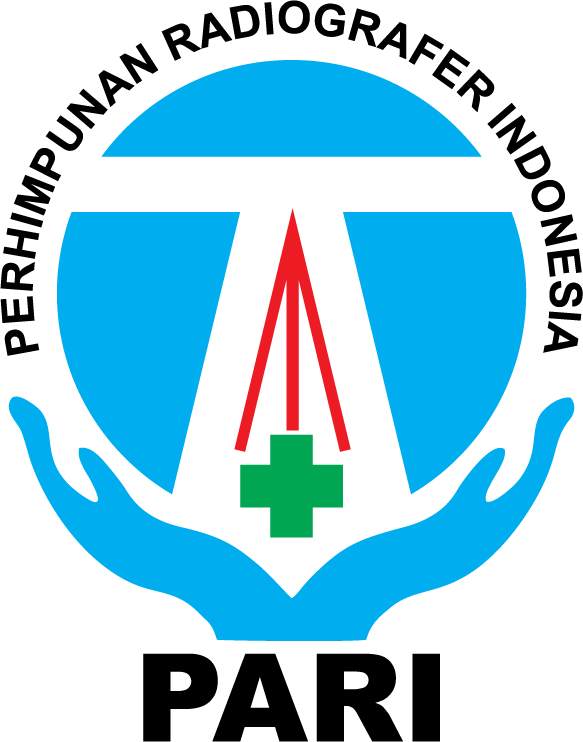Evaluasi Pemeriksaan MRI Brain dengan Klinis Vertigo di Rumah Sakit Otak dr. Drs. M. Hatta Bukittinggi
Abstract
Background: Vertigo is a symptom that arises as a result of disturbances in the balance of the vestibular system or disorders of the central nervous system. A radiological examination that can detect clinical vertigo is an MRI examination. There is a difference in the MRI Brain examination protocol for clinical vertigo between theory and the field, namely the addition of the 3D CISS protocol. The aim of this research is to determine the role of adding 3D CISS to MRI Brain examinations in clinical vertigo.
Methods: This research is qualitative descriptive research, use 10 patients, and do in January to November 2023. Data was collected by observation, conducting interviews and questionnaires. This research use 13 sequences, namely Axial T2 TSE, DWI, Axial T2 TSE Dark Fluid, T2 SWI, Sagittal T1 TSE, Sagittal T2 TSE FS, Axial T1 TSE, Coronal T2 TSE, Coronal T1 TSE, Axial T1 TSE, Coronal, Sagittal + Contrast with cuts at the upper border of the vertex and the lower border of the cerebellum and T2 3D CISS axial isotropic sequences for the cuts used, namely at the level of the sponge, showing the vestibulocochlear cranial nerve (VIII).
Results: The results of the assessment on the T2 3D CISS Axial Isotropic sequence showed that anatomical detail was clearly visible as much as 75% and the spatial resolution was clearly visible as much as 75%.
Conclusions: Brain MRI examination with clinical vertigo provides information that helps in understanding the causes of vertigo, allowing for a more accurate and effective treatment approach.
Keywords
Full Text:
PDFReferences
Catherine Westbrook. (2014). Handbook of MRI TECHNIQUE. In L. John Wiley&Sons (Ed.), Willy Blackwell (4th ed., Vol. 6, Issue August). John Wiley & Sons Ltd.
Cavallaro, M., Coglitore, A., Tessitore, A., Galletta, K., Frosina, L., Cuffari, A., Ingrassia, R., Scarcella, S. C., Caponnetto, M., Longo, M., Granata, F., Vinci, S. L., & Mormina, E. (2022). Three-Dimensional Constructive Interference in Steady State (3D CISS) Imaging and Clinical Applications in Brain Pathology. Biomedicines, 10(11), 2997. https://doi.org/10.3390/biomedicines10112997
Juerg, H. (2023). Diseases of the Brain head and neck, spine 2020-2023. In company Springer Nature Switzerland AG. https://doi.org/10.1007/978-88-470-2131-0_30
Kadhim, M. A., Rasheed, R. M., & Huweidy, B. T. (2019). The role of 3D CISS MRI in the evaluation of primary Trigeminal Neuralgia. Indian Journal of Public Health Research and Development, 10(10), 1146–1151. https://doi.org/10.5958/0976-5506.2019.02982.6
Lee, J. Y., Park, H. M., Lee, B., & Kim, J. (2021). Cranial Nerve Disorders: Clinical Application of High-Resolution Magnetic Resonance Imaging Techniques. Investigative Magnetic Resonance Imaging, 25(4), 281. https://doi.org/10.13104/imri.2021.25.4.281
Muhammad ismanY. (2014). Bunga Rampai Kedokteran. In I. C. Gorontolo (Ed.), https://repository.ung.ac.id/karyailmiah/show/1860/muh-isman-yusuf-vertigo-bunga-rampai-kedokteran.html (1st ed.). NajwaRizfa.perc.
Nizar, S., & Katili, M. I. (2019). Pengaruh variasi time repetition (tr) terhadap Kualitas citradan informasi citra pada pemeriksaan Mri lumbalsekuens t2 fse potongan sagital. Jurnal Imejing Diagnostik (JImeD), 5.
Sari, M. R., & Vierlia, W. V. (2021). Anatomy Physiology and Examination of Optic Nerve. Eye and Sight Journal, 1–11.
Setiawati, M., & Susianti. (2016). Diagnosis dan Tatalaksana Vertigo. Majority, 5(4), 91–95.
Shetty, R., Sharma, G., & Shetty, H. (2019). Three Dimensional Constructive Interference in Steady State Magnetic Resonance Imaging Sequence : A Novel Modality in Imaging of Cranial Nerves. 18(3), 35–39. https://doi.org/10.9790/0853-1803093539
Sri sutarni, R. G. (2018). Bunga Rampai Vertigo. Gajah Mada University Press, 1.
Timotius, K. H. (2018). Otak dan Perilaku. In Andi offset.
Wagner, F., Gandalini, M., Hakim, A., Ermis, E., Leiser, D., Zbinden, M., Anschuetz, L., Raabe, A., Caversaccio, M., Wiest, R., & Herrmann, E. (2018). Radiosurgery of vestibular schwannoma: prognostic factors for hearing outcome using 3D-constructive interference in steady state (3D-CISS). Strahlentherapie Und Onkologie, 194(12), 1132–1143. https://doi.org/10.1007/s00066-018-1361-8
DOI: https://doi.org/10.31983/jimed.v10i1.10970
Article Metrics
Refbacks
- There are currently no refbacks.
JURNAL IMEJING DIAGNOSTIK by http://ejournal.poltekkes-smg.ac.id/ojs/index.php/jimed is licensed under a Creative Commons Attribution-ShareAlike 4.0 International License.

.png)
.png)
.png)
.png)
.png)
.png)
.png)











